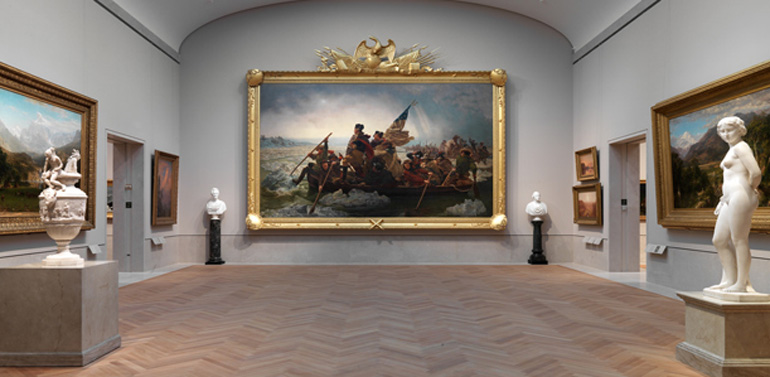Gotham Diary:
Transcendent
20 January 2012
What astonished me most, on my first trip through the newly installed galleries of American painting in the Metropolitan Museum of Art’s American Wing, was the power of Emanuel Leutze’s 1851 icon, Washington Crossing the Delaware. I’d been thinking about this painting ever since the Museum’s Fall 2011 Bulletin announced (to those of us who hadn’t heard the news otherwise) that this very large painting was going to occupy the pride of place in the new configuration.
It would hang alone, at the end of a long room, cased in a replica of the very imposing frame in which it was originally presented. I was very disturbed to learn all of this. I believed that the Museum ought quietly to get rid of the picture, pure kitsch in my eyes. At the very least, it ought to be mounted as far as possible from the Sargents and the Homers and the Cassatts and the Kensitts that form the backbone of a very great collection of American paintings. Instead of which, it stands in the middle of them.
But when, at the end of our tour, I finally stepped into the room, I had to stifle a sob. I was wrong. I was wrong about something. Maybe the Leutze isn’t kitsch — but I don’t think that that’s what I had wrong. More likely it’s the fact that this painting has been revered by generations of American, pored over with all the attentiveness that the Mona Lisa has ever received. The Museum has chosen to honor that interest, and remind the rest of us that pictures can be very powerful in ways that have nothing to do with art, truth, beauty, or anything else that John Keats wrote about.
The Bulletin photographs did not show the other pictures that would hang in the room; presumably, they hadn’t been put up yet. Here, too, the Museum has made an arresting decision. The other pictures are all landscapes, and landscapes, from what I gathered with a sweep of my eye, of the Far West. Mountains, mostly. (Maybe mountains exclusively.) Busts of Washington and Lincoln flank the Leutze, with other noble sculptures standing here and there between the frames. The space is almost ceremonial, as though the room were itself the recreation of an historic chamber. Everything transcendant about the American Dream is represented: the awesome spaciousness of the territory, and the boundless determination to cross it. As in a Gothic cathedral, you do not need to partake in the local orthodoxy to be abashed by its visionary power.
The photograph that I’ve lifted from the Museum’s Web site could not be more misleading in at least one way: in person, Washington Crossing the Delaware looks that small and distant only from the far end of two galleries away. If you are standing anywhere in the room with the painting, it looms immensely, overpoweringly. You walk back to what seems to be a suitable distance for appraising the picture, turn round, and find that you have miscalculated; you’re still too close to take it all in. The grandly deep frame has the air of a strange machine that might begin to whir and grind any moment — perhaps to help Washington’s men break the ice, perhaps something to more apocalyptic end. I had to ask myself, on the spot, to explain how Leutze’s large-form history painting was inferior to, say, The Raft of the Medusa; it is certainly superior to the picture that hangs opposite that work at the Louvre, also by Delacroix: the Death of Sardanaplus. (I may like to think that I’m a sophisticate, cosmopolitan member of the Transatlantic tribe, but I’m not that Continental!) The question remains open.
I look forward to revisiting the galleries many, many times. Many old friends have reappeared there, and I’ll probably make a few new ones. But I hope I never forget the shock of being so improbably awed by Washington Crossing the Delaware.

